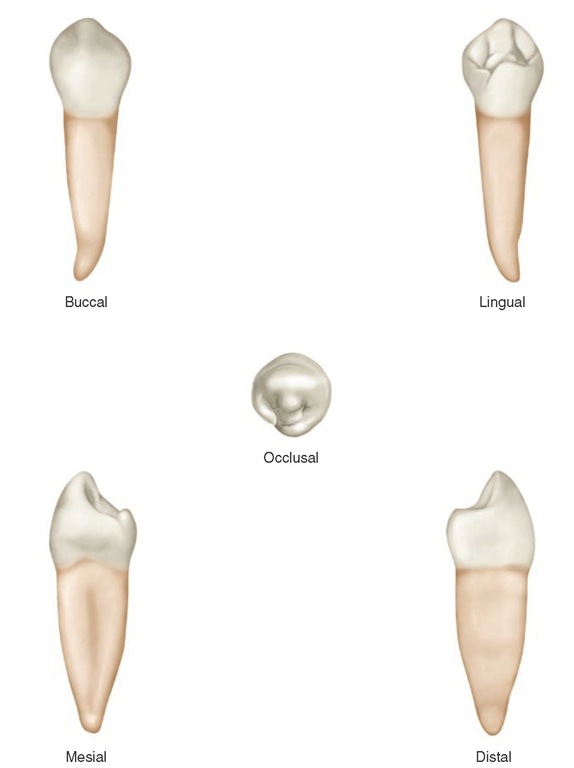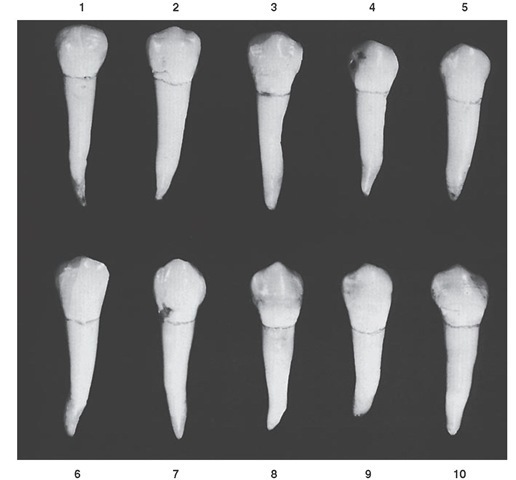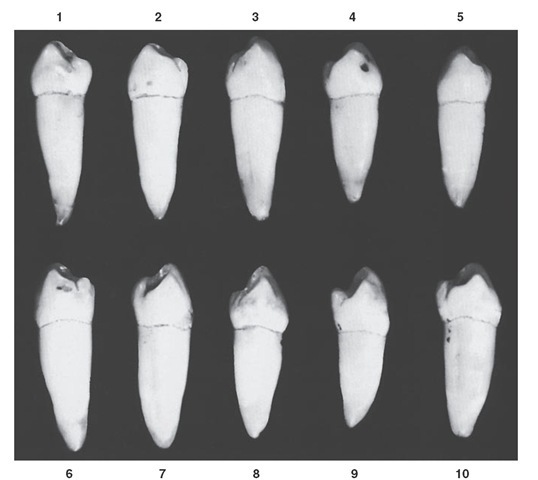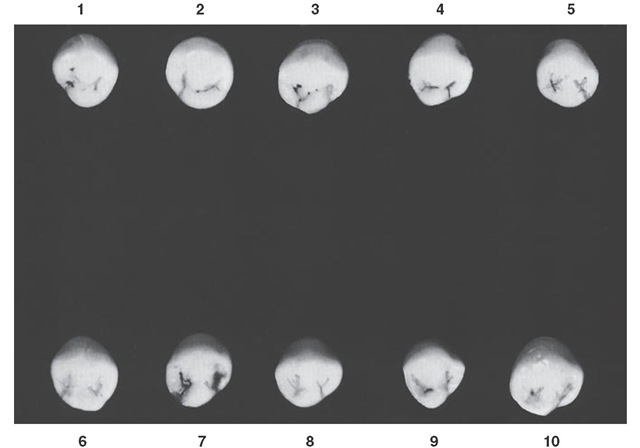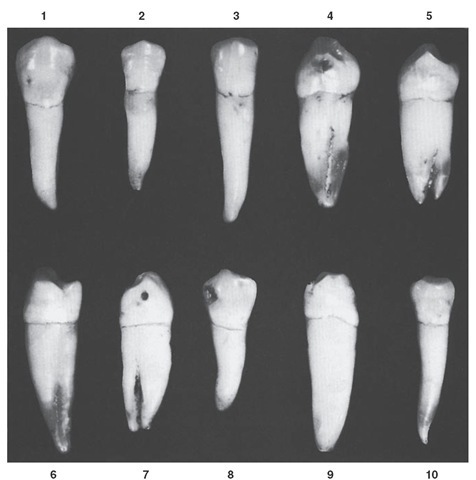Detailed Description of the Mandibular First Premolar From All Aspects
Buccal Aspect
From the buccal aspect, the form of the mandibular first premolar crown is nearly symmetrical bilaterally (see Figures 10-2, 10-7, 10-8, and 10-9). The middle buccal lobe is well developed, which results in a large, pointed buccal cusp. The mesial cusp ridge is shorter than the distal cusp ridge.
The contact areas are broad from this aspect; they are almost at the same level mesially and distally, this level being a little more than half the distance from cervical line to cusp tip. The measurement mesiodistally at the cervical line is small compared with the measurement at the contact areas.
From the buccal aspect, the crown is roughly trapezoidal (see Figure 4-16, C). The cervical margin is represented by the shortest of the uneven sides.
The crown exhibits little curvature at the cervical line buccally, because of the slight curvature of the cervical line on the mesial and distal surfaces of the tooth. The crest of curvature of the cervical line buccally approaches the center of the root buccally.
Fìgure 10-8 Mandibular right first premolar.
Table 10-1 Mandibular First Premolar
Figure 10-9 Mandibular first premolar, buccal aspect. Ten typical specimens are shown.
Figure 10-10 Mandibular second premolar, occlusal aspect. Ten typical specimens are shown.
Figure 10-11 Mandibular first premolar, occlusal aspect. Ten typical specimens are shown.
Figure 10-12 Mandibular first premolar. Ten specimens with uncommon variations are shown. 1, Crown oversized. 2, Crown and root diminutive. 3, Mesial and distal sides of crown straight; cervix wide mesiodistally; root extra long. 4, Unusual formation of lingual portion of crown; root with deep developmental groove mesially. 5, Bifurcated root. 6, Lingual cusp long; little lingual curvature; root of extra length. 7, No lingual cusp; root bifurcated. 8, Dwarfed root. 9, Crown poorly formed; root unusually long. 10, Very long curved root for crown so small.
The mesial outline of the crown is straight or slightly concave above the cervical line to a point where it joins the curvature of the mesial contact area. The center of the contact area mesially is occlusal to the cervical line, a distance equal to a little more than half the crown length. The outline of the mesial slope of the buccal cusp usually shows some concavity unless wear has obliterated the original form.
The tip of the buccal cusp is pointed and, in most cases, is located a little mesial to the center of the crown buccally (see Figure 10-9, 3, 7, 8, and 9). The mandibular canine has the same characteristic to a greater degree.
The distal outline of the crown is slightly concave above the cervical line to a point where it is confluent with the curvature describing the distal contact area. This curvature is broader than that describing the curvature of the mesial contact area. The distal slope of the buccal cusp usually exhibits some concavity.
The cervix of the mandibular first premolar crown is narrow mesiodistally when compared with the crown width at the contact areas.
The root of this tooth is 3 or 4 mm shorter than that of the mandibular canine, although the outline of the buccal portion of the root bears a close resemblance to that of the canine.
The buccal surface of the crown is more convex than in the maxillary premolars, especially at the cervical and middle thirds.
The development of the middle buccal lobe is outstanding, ending in a pointed buccal cusp. Developmental depressions are often seen between the three lobes (see Figure 10-9, 2, 3, 8, and 10).
The continuous ridge from the cervical margin to the cusp tip is called the buccal ridge.
In general, the enamel of the buccal surface of the crown is smooth and shows no developmental grooves and few developmental lines. If the latter are present, they are seen as very fine horizontal cross lines at the cervical portion.
Lingual Aspect
The crown of the mandibular first premolar tapers toward the lingual, since the lingual measurement mesiodistally is less than that buccally. The lingual cusp is always small (see Figures 10-3, 10-7, and 10-8). The major portion of the crown is made up of the middle buccal lobe (see Figure 1011). This makes it resemble the canine.
The crown and the root taper markedly toward the lingual so that most of the mesial and distal surfaces of both may be seen from the lingual aspect.
The occlusal surface slopes greatly toward the lingual in a cervical direction down to the short lingual cusp. Most of the occlusal surface of this tooth can therefore be seen from this aspect.
The cervical portion of the crown lingually is narrow and convex, with concavities in evidence between the cervical line and the contact areas on the lingual portion of mesial and distal surfaces. The contact areas and marginal ridges are pronounced and extend out above the narrow cervical portion of the crown.
Although the lingual cusp is short and less developed (resembling a strongly developed cingulum at times), it usually shows a pointed tip. This cusp tip is in alignment with the buccal triangular ridge of the occlusal surface, which is in plain view. The mesial and distal occlusal fossae are on each side of the triangular ridge (see Figure 10-1).
A characteristic of the lingual surface of the mandibular first premolar is the mesiolingual developmental groove. This groove acts as a line of demarcation between the mesiobuc-cal lobe and the lingual lobe and extends into the mesial fossa of the occlusal surface.
The root of this tooth is much narrower on the lingual side, and there is a narrow ridge, smooth and convex, the full length of the root. This formation allows most of the mesial and distal surfaces of the root to be seen. Often, developmental depressions in the root may be seen with developmental grooves mesially. The root of this tooth tapers evenly from the cervix to a pointed apex.
Mesial Aspect
From the mesial aspect (see Figures 10-4, 10-7, 10-8, and 10-10), the mandibular first premolar shows an outline that is fundamental and characteristic of all mandibular posterior teeth when viewed from the mesial or distal aspect. The crown outline is roughly rhomboidal (see Figure 4-16, E), and the tip of the buccal cusp is nearly centered over the root. The convexity of the outline of the lingual lobe is lingual to the outline of the root. The surface of the crown presents an overhang above the root trunk in a lingual direction. The tip of the cusp is on a line approximately with the lingual border of the root. This differs from the situation found in maxillary posterior teeth, where both buccal and lingual cusp tips are well within the confines of the root trunks.
The mandibular first premolar, when viewed from the mesial aspect, often shows the buccal cusp centered over the root (see Figure 10-4). In other instances, the buccal cusp tip is a little buccal to the center, corresponding to the typical placement of buccal cusps on all mandibular posterior teeth.
The buccal outline of the crown from this aspect is prominently curved from the cervical line to the tip of the buccal cusp; the crest of the curvature is near the middle third of the crown. This accented convexity and the location of the crest of contour are characteristic of all mandibular posterior teeth on the buccal surfaces.
The lingual outline of the crown, representative of the lingual outline of the lingual cusp, is a curved outline of less convexity than that of the buccal surface. The crest of curvature lingually approaches the middle third of the crown, with the curvature ending at the tip of the lingual cusp, which is in line with the lingual border of the root.
The distance from the cervical line lingually to the tip of the lingual cusp is about two thirds of that from the cervical line buccally to the tip of the buccal cusp.
The mesiobuccal lobe development is prominent from this aspect; it creates by its form the mesial contact area and the mesial marginal ridge, which in turn has a sharp inclination lingually in a cervical direction. The lingual border of the mesial marginal ridge merges with the developmental depression mesiolingually; this harbors the mesiolingual developmental groove.
Some of the occlusal surface of the crown mesially may be seen with the mesial portion of the buccal triangular ridge. The slope of this ridge parallels that of the mesial marginal ridge, although the crest of the triangular ridge is above it. The sulcus formed by the convergence of buccal and lingual triangular ridges is directly above the mesiolin-gual groove from this aspect.
The cervical line on the mesial surface is rather regular, curving occlusally. The crest of the curvature is centered buccolingually, the average curvature being about 1 mm in extent. It may, however, be a fraction of a millimeter, or the line may be straight across buccolingually.
The surface of the crown mesially is smooth except for the mesiolingual groove. The surface is plainly convex at the mesial contact area, which is centered on a line with the tip of the buccal cusp. Immediately below the convexity of the contact area, the surface is sharply concave between that area and the cervical line. The distance between the contact area and the cervical line is very short.
The root outline from the mesial aspect is a tapered form the cervix, ending in a relatively pointed apex in line with the tip of the buccal cusp. The lingual outline may be straight, the buccal outline more curved.
The mesial surface of the root is smooth and flat from the buccal margin to the center. From this point, it too converges sharply toward the root center lingually, often displaying a deep developmental groove in this area. Shallow grooves are nearly always in evidence, and occasionally a deep developmental groove will end in a bifurcation at the apical third (see Figure 10-12, 5 and 7).
Distal Aspect
The distal aspect of the mandibular first premolar differs from the mesial aspect in some respects (see Figures 10-5, 10-7, and 10-8). The distal marginal ridge is higher above the cervix, and it does not have the extreme lingual slope of the mesial marginal ridge, being more nearly at right angles to the axis of crown and root. The marginal ridge is confluent with the lingual cusp ridge; it has no developmental groove on the distal marginal ridge. The major portion of the distal surface of the crown is smoothly convex, the spheroidal form having an unbroken curved surface.
Below this curvature and just above the cervical line, a concavity is to be noted that is linear in form and that extends buccolingually. The distal contact area is broader than the mesial, although it is centered in the same relation to the crown outlines. The center of the distal contact area is at a point midway between buccal and lingual crests of curvature and midway between the cervical line and the tip of the buccal cusp.
The curvature of the cervical line distally may be the same as that found mesially, although less curvature distally is the general rule when one is describing all posterior teeth.
The surface of the root distally exhibits more convexity than was found mesially. A shallow developmental depression is centered on the root, but rarely does it contain a deep developmental groove.
The distal surface slopes from the buccal margin toward the center of the root lingually, but the slope is more gradual than that found mesially.
Occlusal Aspect
The occlusal aspects of many specimens show considerable variation in the gross outlines of this tooth. Both mandibular premolars exhibit more variations in form occlusally than do the maxillary premolars (see Figures 10-6, 10-7, 10-8, and 10-11).
The usual outline form of the mandibular first premolar from the occlusal aspect is roughly diamond-shaped and similar to the incisal aspect of mandibular canines (see Figure 10-11, 1, 3, 4, and 7 through 10). Some of these teeth have a circular form similar to that of some mandibular second premolars (see Figure 10-11, 2); others conform to the gross outlines of the more common second premolars (see Figure 10-11, 5 and 6).
The characteristics common to all mandibular first premolars, regardless of type, when viewed from the occlu-sal aspect are as follows:
1. The middle buccal lobe makes up the major bulk of the tooth crown.
2. The buccal ridge is prominent.
3. The mesiobuccal and distobuccal line angles are prominent, although rounded.
4. The curvatures representing the contact areas, immediately lingual to the buccal line angles, are relatively broad, with the distal area being the broader of the two.
5. The crown converges sharply to the center of the lingual surface, starting from points approximating the mesial and distal contact areas. This formation makes that part of the crown represented by buccal cusp ridges, marginal ridges, and lingual lobe triangular in form, with the base of the triangle at the buccal cusp ridges and the point of the triangle at the lingual cusp.
6. The marginal ridges are well developed.
7. The lingual cusp is small.
8. The occlusal surface shows a heavy buccal triangular ridge and a small lingual triangular ridge.
The occlusal surface harbors two depressions. These are called the mesial and distal fossae because of their irregular form, even though they correspond in location to the mesial and distal triangular fossae of other posterior teeth.
The most common type of mandibular first premolar shows a mesiolingual developmental depression and groove. These constrict the mesial surface of the crown and create a smaller mesial contact area that is in contact with the mandibular canine. The distal portion of the crown is described by a larger arc that creates a broader contact area in contact with the second mandibular premolar, which has a broader proximal surface than the canine (see Figures 5-7, D, 5-10, B, and 5-17, D).
The mesial fossa is more linear in form, being more sulcate and containing the mesial developmental groove, which extends buccolingually. This groove is confluent with its extension, which becomes the mesiolingual developmental groove as it passes over the mesiolingual surface. The distal fossa is more circular in most cases and is circumscribed by the distobuccal cusp ridge, the distal marginal ridge, the buccal triangular ridge, and the distolingual cusp ridge.
The distal fossa may contain a distal developmental groove that is crescent-shaped (see Figure 10-11, 2). It may harbor a distal developmental pit with accessory supplemental grooves radiating from it (see Figure 10-11, 10), or it may contain a linear groove running mesiodistally with an arrangement resembling the typical triangular fossa (see Figure 10-11, 4, 5, and 6).
Because of the position of this crown over the root, most of the buccal surface may be seen from the occlusal aspect, whereas very little of the lingual surface is in view.
